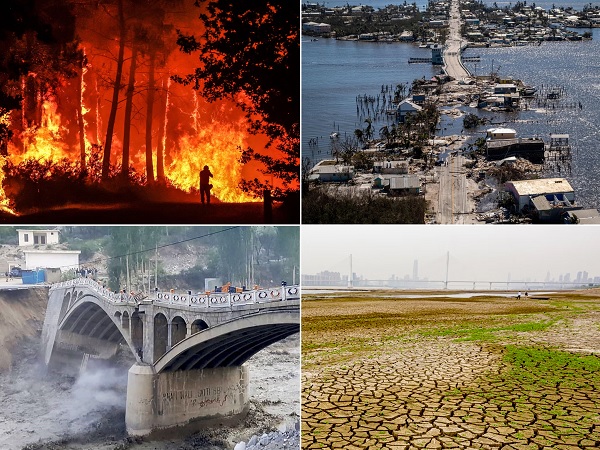
Climate change and natural disasters have rapidly evolved into critical threats to the economies of nations worldwide. The increasing frequency and severity of extreme weather events, coupled with the long-term impacts of climate change, pose multifaceted challenges that extend well beyond environmental concerns. Here, we delve into the complex landscape of how climate change and natural disasters have become major threats to a country's economy. By exploring the diverse economic implications and the pressing need for strategic interventions, we aim to underscore the urgency of addressing these challenges to ensure sustainable economic development.
Infrastructure Damage and Reconstruction Costs:
Natural disasters, ranging from hurricanes and earthquakes to floods and wildfires, cause extensive damage to a country's infrastructure. The aftermath requires substantial financial resources for reconstruction. The economic toll of rebuilding damaged roads, bridges, buildings, and utilities diverts funds from essential sectors, hindering economic growth and development.
Agricultural Disruption:
Climate change-induced shifts in weather patterns and the increased frequency of extreme events disrupt agricultural activities. Crop failures, reduced yields, and damage to livestock pose substantial threats to food production. The resulting impact on agricultural economies can lead to increased food prices, food shortages, and heightened economic vulnerability, particularly in countries where agriculture is a significant economic sector.
Supply Chain Disruptions:
Natural disasters can cause widespread disruptions to supply chains, affecting the production and distribution of goods and services. Industries heavily reliant on consistent and timely inputs face challenges when key components are unavailable due to disruptions in other parts of the supply chain. Such disruptions contribute to production delays, increased costs, and economic losses.
Increased Insurance Costs:
The heightened frequency and severity of natural disasters contribute to increased insurance costs for businesses and individuals. Higher premiums place additional financial burdens on businesses, impacting their bottom line. Individuals also face rising insurance costs, reducing their disposable income and potentially slowing down consumer spending, a key driver of economic growth.
Healthcare Costs:
Climate change-related health impacts, such as the spread of diseases and the exacerbation of health conditions due to extreme weather events, contribute to increased healthcare costs. Treating injuries, illnesses, and addressing public health emergencies place strains on healthcare systems, resulting in higher expenditures that can adversely affect both public and private finances.
Loss of Tourism Revenue:
Natural disasters, particularly those affecting popular tourist destinations or coastal areas, can lead to a decline in tourism. The loss of tourism revenue has cascading effects on local businesses, jobs, and government revenue. Countries heavily dependent on tourism face economic downturns, highlighting the vulnerability of this sector to climate-related disruptions.
Displacement and Migration:
Climate change-induced natural disasters, coupled with long-term environmental changes, contribute to population displacement and migration. The movement of people places strains on resources in both areas of origin and destination, leading to social tensions and economic challenges. The economic impacts of managing displaced populations extend beyond immediate humanitarian concerns.
Increased Financial Vulnerability:
The financial impacts of climate change and natural disasters contribute to increased economic vulnerability. Countries may struggle to meet debt obligations, and the process of rebuilding after disasters can strain government budgets, leading to fiscal deficits. Financial vulnerabilities may, in turn, affect investor confidence and economic stability.
Impact on Energy Production:
Climate change can affect energy production, especially in regions dependent on specific energy sources vulnerable to extreme weather events. Disruptions in power generation and distribution can lead to energy shortages, hindering industrial production and economic growth. Transitioning to more resilient and sustainable energy sources becomes imperative for economic stability.
Long-Term Economic Consequences:
The cumulative effects of frequent natural disasters and ongoing climate change can lead to long-term economic consequences. Countries may experience a decline in economic growth, reduced investment, and diminished economic resilience. The compounding impacts underscore the need for proactive measures to address climate-related threats to ensure sustainable economic development.
In conclusion, climate change and natural disasters have evolved into major threats to national economies, presenting complex challenges that demand urgent attention. The economic implications of infrastructure damage, agricultural disruption, supply chain interruptions, increased insurance costs, healthcare expenditures, and the loss of tourism revenue highlight the multifaceted nature of these threats. Addressing the impacts of climate change and enhancing resilience against natural disasters are not only environmental imperatives but also crucial for fostering economic stability and sustainable development. Global cooperation and comprehensive strategies are essential to mitigate the economic risks posed by climate-related challenges and pave the way for a more resilient and sustainable future. The time for action is now, as the consequences of inaction will reverberate through economies for generations to come.